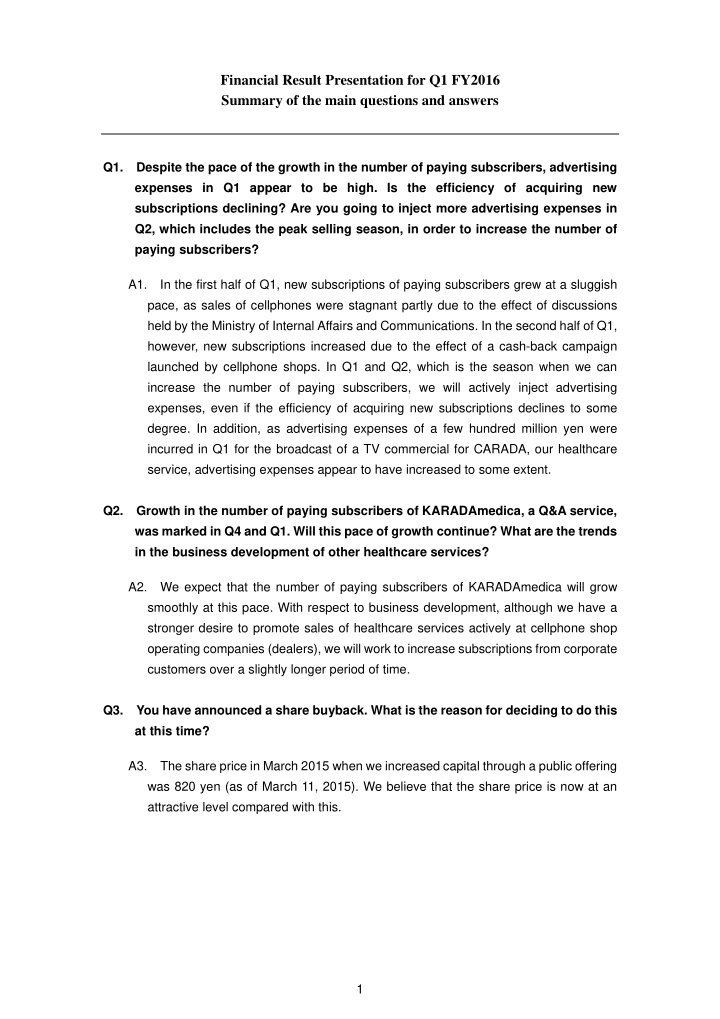



Financial Result Presentation for Q1 FY2016 Summary of the main questions and answers Q1. Despite the pace of the growth in the number of paying subscribers, advertising expenses in Q1 appear to be high. Is the efficiency of acquiring new subscriptions declining? Are you going to inject more advertising expenses in Q2, which includes the peak selling season, in order to increase the number of paying subscribers? A1. In the first half of Q1, new subscriptions of paying subscribers grew at a sluggish pace, as sales of cellphones were stagnant partly due to the effect of discussions held by the Ministry of Internal Affairs and Communications. In the second half of Q1, however, new subscriptions increased due to the effect of a cash-back campaign launched by cellphone shops. In Q1 and Q2, which is the season when we can increase the number of paying subscribers, we will actively inject advertising expenses, even if the efficiency of acquiring new subscriptions declines to some degree. In addition, as advertising expenses of a few hundred million yen were incurred in Q1 for the broadcast of a TV commercial for CARADA, our healthcare service, advertising expenses appear to have increased to some extent. Q2. Growth in the number of paying subscribers of KARADAmedica, a Q&A service, was marked in Q4 and Q1. Will this pace of growth continue? What are the trends in the business development of other healthcare services? A2. We expect that the number of paying subscribers of KARADAmedica will grow smoothly at this pace. With respect to business development, although we have a stronger desire to promote sales of healthcare services actively at cellphone shop operating companies (dealers), we will work to increase subscriptions from corporate customers over a slightly longer period of time. Q3. You have announced a share buyback. What is the reason for deciding to do this at this time? A3. The share price in March 2015 when we increased capital through a public offering was 820 yen (as of March 11, 2015). We believe that the share price is now at an attractive level compared with this. 1
Q4. The ratio of high billing rates of music/books/video services exceeded 30% in Q4 and Q1. What level do you expect at the end of the current fiscal year? A4. The ratio of high billing rates rose about 20 percentage points over a year, from 10% at the end of September 2014 to 33% at the end of September 2015. As the ratio has also risen about five percentage points in Q1, we believe that it will continue to rise in the months ahead, and that it will reach around 50% at the end of the current fiscal year. Q5. Contracts with Hollywood movie title companies appear to be increasing in videos. When do you think you will sign a contract with other companies? Is it possible to develop higher billing services by enhancing movie titles? A5. Although we are currently in negotiations, we believe that we will be able to sign a contract with all Hollywood movie title companies by the end of the current fiscal year. As we are also thinking about lining up famous move titles other than those in Hollywood, we will prepare for higher billing services. Q6. The TV commercial for CARADA was actively broadcast during the year-end and New Year season. What effect has it had? A6. What is broadcast in the TV commercial is a free application service. We are also increasing sales of CARADA, which provides fee-based services for corporations, through the corporate sales division of cellphone shop operating companies (dealers), and are expanding the number of contracts with sports gyms. We would therefore say that the TV commercial is getting good results in the sense that it is increasing the recognition of CARADA. Q7. What is the ratio of health service categories with high billing rates? A7. Around 40% as of the end of December 2015. Q8. Earnings in Q1 appear to be firm in terms of the progress of your earnings forecast. Are you going to spend advertising expenses as planned during the peak selling season in Q2? Do you expect that income will be higher than planned? A8. At this time, we expect that operating income will be as planned. If the selling season misfired with sales of cellphones declining, operating income could be higher than expected, as advertising expenses will not be used up as planned. 2
Q9. Sales for docomo Sugo Toku were on an upward trend until the previous quarter. What is the reason for the first quarter-on-quarter decline in Q1? A9. There are two reasons. The first is the revision of the revenue share according to the number of accesses from NTT Docomo. The other is a decline in the number of accesses through our own application (Checklock). Although the number of accesses to our Sugo Toku content increased steadily as we had cellphone shops encourage the download of Checklock, the number of accesses declined as we began operating Checklock for other companies (white mediatization), in addition to operating it for our own sake. We plan to operate multiple applications with a similar function other than Checklock going forward, and the operation of these applications for other companies will become our advertising revenue. We will therefore increase the operation of these applications as “Sogo Toku-related sales,” including their advertising revenue. Q10. Is there any impact of changes in the tariff plan of carriers? A10. If the movement of abolishing the so-called “zero tariff” plan of cellphone carriers is limited to new models, we believe that there will be little impact, as in the past. 3
Recommend
More recommend